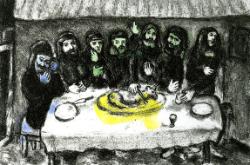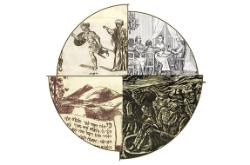News
MEDIA CONTACT
Steve Christensen
LUMA
312.915.6164
schris6@luc.edu
Two Celebrate Passover and One Explores the Role of Fathers
CHICAGO, February 14, 2013 – The Loyola University Museum of Art (LUMA) presents three exhibitions this spring: Graven Images: Marc Chagall’s Bible Illustrations, The Truth is in the Telling: Tradition and Innovation in Passover Haggadot from the Stephen P. Durchslag Collection,and Lewis Kostiner: Choosing Fatherhood—A Photographic Journey. All three exhibitions open on March 2 and continue through June 2, 2013.

Graven Images: Marc Chagall’s Bible Illustrations
Born in Vitebsk, Belarus, into a traditional Hasidic Jewish culture with no tradition of art, Marc Chagall developed into one of the most distinctive artists of the 20th century. In Chicago, he is best known for stained glass windows at the Art Institute of Chicago, as well as The Four Seasons mosaic at 10 South Dearborn Street. Like his colorful paintings, these works are peopled with gravity-defying figures drawn from east European Jewish folklore.
Few people recognize that Chagall was also a highly skilled printmaker, having learned the technique while residing in Germany in the 1920s. Chagall’s The Bible Series represents his finest work in the print medium. When completed in 1957, the modern art critic Clement Greenberg extolled his prints as the finest by a modern artist, better even than the prints of Pablo Picasso. In Jewish culture, with no tradition of art, Marc Chagall developed into one of the most distinctive artists of the 20th century. In Chicago, he is best known for stained glass windows at the Art Institute of Chicago, as well as The Four Seasons mosaic at 10 South Dearborn Street. Like his colorful paintings, these works are peopled with gravity-defying figures drawn from east European Jewish folklore.
As a Jewish artist, Chagall broke new ground by illustrating the Hebrew Bible. In accordance with the second commandment against graven images, Hebrew bibles traditionally were not illustrated. Chagall ultimately produced 105 prints, depicting episodes of his own choosing. Many underscore the special covenant between God and the Jews as his Chosen People. Chagall particularly favored moments of divine or angelic intervention or revelation, as in The Vision of Isaiah. Just as Hasidic folklore underlies some of Chagall’s imagery, inflections of Jewish suffering from Russian pogroms to the Holocaust are to be found in scenes such as The Capture of Jerusalem.
While Chagall’s idea, The Bible Series was initially the commercial venture of the great modernist art dealer, Ambroise Vollard. He dealt with all the leading artists of the pre-war period, including Paul Cézanne, Henri Matisse, and Edgar Degas. Vollard’s death in the summer of 1939 and the subsequent outbreak of World War II delayed the project until 1957.
When complete, only 395 sets were printed, of which 100 were printed on Velin d’Arches paper and hand-colored and initialed by Chagall. LUMA will be exhibiting prints from one of these hand-colored sets, the property of the Haggerty Museum of Art at Marquette University.

The Truth is in the Telling
This exhibition highlights the Haggadah, the book that for five centuries tells the story of the Jewish Exodus from Egypt. The story recounts the journey of the Israelites from slavery in Egypt to freedom in the present moment. It is read aloud by Jews throughout the world at the traditional ritual meal of the Seder and is one of the most frequently published books around the globe. Wherever a Jewish community is established, soon appears a new Haggadah expressing hope for a free people and the chance to be “next year in Jerusalem.”
Pesach Weinstein curated the exhibition that was shown in 2012 at the Special Collections Research Center Exhibition Gallery at the University of Chicago. LUMA’s presentation includes additional volumes for a total of 52 Haggadot (plural of Haggadah) and has been culled from the collection of Chicagoan Stephen P. Durchslag. The oldest Haggadah on view dates from 1485, and the collection includes texts for Sephardic and Ashkenazi Jews up to the present. The Khaki Haggadah, for example, was carried in World War I by German-Jewish soldiers. Contemporary Haggadot often encompass modern social issues, such as the Holocaust, violence against women, gay rights, and weapons of mass destruction.
Mr. Durchslag began his collection in 1982 after coming across an 1867 Haggadah in an antique shop in New York City. Now more than 30 years later, his collection consists of over 4,500 volumes written in 31 languages.
The Haggadah is not a sacred text, so there is not the standard Jewish prohibition against depicting figures. Medieval Haggadah manuscripts feature elaborate illustrations of biblical characters and are beautifully calligraphic. Artists such as Otto Geismar (1928), Ben Shahn (1966), Shlomo Katz (1978), Raymond Moretti (1980), Arthur Szyk (1939), and David Wander (1985) illustrate modern Haggadot and the Had Gadya portion of the Seder.
Jews coming of age in the mid-20th century will remember the Maxwell House Haggadah first published in 1932. It was used by President Barack Obama at the 2012 White House Seder.
This exhibition is one of diverse creative expressions showing how the truly living vehicle of the Haggadah delivers the ageless Passover story in different ways, society to society and decade to decade.

Lewis Kostiner: Choosing Fatherhood—A Photographic Journey
On view in the Harlan J. Berk, Ltd. Works on Paper Gallery, Choosing Fatherhood features a selection of photographs from Chicagoan Lewis Kostiner’s photographic project of the same name. These works explore how fathers are involved in their children’s lives. Between 2007 and 2009, the artist traveled to 17 American cities, meeting families and photographing scenes that allude to the important roles of the fathers he met.
In the exhibition, Kostiner’s portraits are accompanied by commentary from Juan Williams of Fox News; David Travis, former curator of photography at the Art Institute of Chicago; Shipra S. Parikh, a licensed clinical social worker who also teaches and conducts research at Loyola University Chicago and the University of Chicago; Roland C. Warren, former president of the National Fatherhood Initiative and a past member of President Obama’s task force on responsible fatherhood; and Derrick M. Bryan, a sociologist at Morehouse College.
The American family comes in all sizes, shapes, and traditions. Forty years ago only 11 percent of America’s children lived in homes without fathers. Today, more than one-third do. Unfortunately, the absence of fathers from their children’s lives is a social problem directly related to high rates of poverty, high school dropouts, incarceration, and multiple behavioral issues.
President Barack Obama declared, “Of all the rocks upon which we build our lives, we are reminded today that family is the most important. And we are called to recognize and honor how critical every father is to that foundation. They are teachers and coaches. They are mentors and role models. They are examples of success and the men who constantly push us toward it.”
“LUMA is excited to present this marvelous chronicle of the importance of a father’s presence in the life of a child,” said Pamela Ambrose, LUMA’s director. “Lewis Kostiner’s resonant images speak to people of all backgrounds.”
Choosing Fatherhood: America’s Second Chance (2012: GFT Publishing)is on sale at the Loyola University Museum of Art
Public Programming
All events take place at LUMA, 820 N. Michigan Avenue, Chicago, Illinois 60611.
Opening Reception
Saturday, March 2, 5:30 p.m.
Join us for the opening of Graven Images: Marc Chagall’s Bible Illustrations, The Truth is in the Telling: Tradition and Innovation in Passover Haggadot from the Stephen P. Durchslag Collection,and Lewis Kostiner: Choosing Fatherhood—A Photographic Journey. Admission is $15 and free for LUMA members.
What’s So Special about the Passover Haggadah?
Tuesday, March 5, 6 p.m.
This lecture by The Hebrew University of Jerusalem Professor Menahem Blondheim provides a revolutionary reading of the Passover Haggadah, the text printed in more editions than any other in the history of Jewish printing, and probably in the history of world printing as well. He will argue that, paradoxically, the Haggadah is the “worst” text on the Jewish bookshelf, or rather, that it actually says nothing. It is merely a guide for oral discourse, and this subversion of literacy is the source of its tremendous historical power. The Haggadah and the conversation it structures (along with matzah balls and other contraptions) are what made the Seder the most successful Jewish ritual in history. The program is co-sponsored by the American Friends of The Hebrew University of Jerusalem. Admission is $10 for the public and $5 for LUMA members and the Loyola community.
Meet the Collector
Tuesday, March 12, 6 p.m.
Collecting Haggadot for more than 30 years, Chicagoan Steve Durchslag has amassed 4,500 volumes, making his collection one of the largest privately held libraries in the world. Meet the man behind the exhibition, The Truth is in the Telling, and get a glimpse into the fascinating world of Haggadot. Admission is free.
A Haggadah for Our Time
Tuesday, April 9, 6 p.m.
For centuries, Jewish communities around the world have used Haggadot to retell the biblical story of the Exodus at the Passover Seder. Each generation sees the creation of new Haggadot, which explore Passover’s themes of justice and freedom in ways that are relevant and meaningful for its time. Rabbi Alison Abrams, from the Jewish Council on Urban Affairs, will discuss how the power of this ancient story finds expression in a variety of communities through
contemporary Haggadot. The program is co-sponsored by Hillel at Loyola. Admission is $4 for the public and free for LUMA members and the Loyola community.
Chagall: Convergence and Divergence with his Jewish Contemporaries
Tuesday, April 16, 6 p.m.
This talk will explore the art of Marc Chagall in relation to his Jewish contemporaries. Rachel Kupferman, formerly of Yeshiva University Museum, will examine themes, media, techniques, and geography. She will also discuss how Chagall’s art is both an extension of traditional Jewish art practices and a revolutionary departure. The program is co-sponsored by Hillel at Loyola. Admission is $4 for the public and free for LUMA members and the Loyola community.
Chagall, the Bible, and Chicago
Tuesday, April 23, 6 p.m.
We expect modern art to break the rules, but today Marc Chagall’s floating, whimsical forms may delight but no longer astound. Yet this devoutly Jewish artist’s illustrations for the Bible defy his faith’s proscription against images, and at the same time fly in the face of traditional Christian iconography. Dr. Paula Wisotzki, from Loyola’s art history department, will explore this series of prints and consider related projects from Chagall’s career, some of which brought him in direct contact with Chicago’s art world. Admission is $4 for the public and free for LUMA members and the Loyola community.
Fatherhood: Ideas and Illustrations of Modern Parenting
Tuesday, April 30, 6 p.m.
In conjunction with Choosing Fatherhood, LUMA will host photographer Lewis Kostiner and Shipra Parikh, PhD, LCSW, adjunct professor at Loyola’s School of Social Work. They will discuss modern fatherhood and what they have learned about men, their desires, and their ability to raise children. Mr. Kostiner uses photography to capture that which cannot be described—the connection between fathers and their children. Dr. Parikh will provide a social work research framework in which to situate contemporary fatherhood. Admission is free.
Small Museums of Paris: Musées Moreau, Rodin, and Zadkine
Tuesday, May 7, 6 p.m.
Paris is famous for its grand museums, but it is also a city of numerous small, more intimate spaces, often devoted to the work and life of a single artist. Many were also the artist’s original residence and studio so that visitors could appreciate the artist’s work in the very place in which it was created. Parisian gallerist Christophe Boïcos will discuss three of the most beautiful and evocative museums in the city, highlighting the work of artists of the early-modern era, who each in his own way sought to create an art that brought spiritual and mythical values back into the art world: Gustave Moreau (1826–1898), Auguste Rodin (1840–1917), and Ossip Zadkine (1890–1967). Admission is $15 for the public and $5 for LUMA members and the Loyola community.
Chagall’s America Windows: Theme and Process
Tuesday, May 14, 6 p.m.
The reinstallation of Marc Chagall’s America Windows at the Art Institute of Chicago has prompted new research into this late project by one of the great 20th-century artists. Art historian and Loyola alum Dr. Michelle Paluch-Mishur will take an in-depth look at the theme of the windows and the technical process used to transform Chagall’s designs on paper into large-scale artworks produced in the studio of Charles Marq. The presentation also reveals the background behind this important commission. Admission is $4 for the public and free for LUMA members and the Loyola community.
Image Credit
Marc Chagall, The Passover Feast (from The Bible Series), 1957, hand-colored etching, gift of Mr. and Mrs. Patrick Haggerty, collection of the Haggerty Museum of Art, Marquette University 80.7.96. © 2013 Artists Rights Society (ARS), New York / ADAGP, Paris.
Haggadot collage, Collection of Stephen P. Durchslag
Natalie, Holding A Photograph Of Her Father, Reynol Ruiz, Redwood City, California (2008), Lewis Kostiner
Copyright protected images are being provided in reference to the Loyola University Museum of Art exhibition Graven Images: Marc Chagall’s Bible Illustrations (March 2, 2013 – June 2, 2013) only. Please note, journalists wishing to use copyright protected images for any manner other than timely reporting and exhibition review must first clear rights with ARS, 536 Broadway, Fifth Floor, New York, NY 10012 INFO@ARSNY.COM (P) 1.212.420.9160 (F): 1.212.420.9286.
About LUMA
Opened in 2005, the Loyola University Museum of Art is dedicated to exploring, promoting, and understanding art and artistic expression that illuminates the enduring spiritual questions of all cultures and societies. As a museum with an interest in education and educational programming, LUMA reflects the University’s Jesuit mission and is dedicated to helping people of all creeds explore the roots of their faith and spiritual quests. Located at Loyola University Chicago’s Water Tower Campus, the museum occupies the first three floors of the University’s historic Lewis Towers on Chicago’s famous Michigan Avenue. For more information, visit the museum’s website at LUC.edu/luma.
Art illuminating the spirit!
-LUMA-


